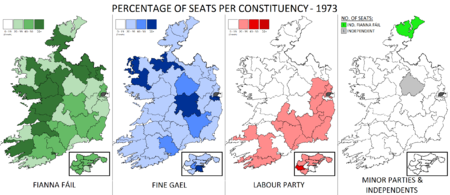Irish general election, 1973
|
|
|||||||||||||||||||||||||||||||||||||||||||||||||
|---|---|---|---|---|---|---|---|---|---|---|---|---|---|---|---|---|---|---|---|---|---|---|---|---|---|---|---|---|---|---|---|---|---|---|---|---|---|---|---|---|---|---|---|---|---|---|---|---|---|
|
|||||||||||||||||||||||||||||||||||||||||||||||||
|
|
|||||||||||||||||||||||||||||||||||||||||||||||||
|
143 of 144 seats in Dáil Éireann 72 seats were needed for a majority |
|||||||||||||||||||||||||||||||||||||||||||||||||
| Turnout | 76.6% | ||||||||||||||||||||||||||||||||||||||||||||||||
|
|||||||||||||||||||||||||||||||||||||||||||||||||

Percentage of seats gained by each of the three major parties, and number of seats gained by smaller parties and independents.
|
|||||||||||||||||||||||||||||||||||||||||||||||||
|
|||||||||||||||||||||||||||||||||||||||||||||||||
The Irish general election of 1973 was held on 28 February 1973. The newly elected 144 members of the 20th Dáil assembled at Leinster House on 4 March when the new Taoiseach and government were appointed.
The general election took place in 42 parliamentary constituencies throughout Ireland for 144 seats in the lower house of parliament, Dáil Éireann.
By the time the general election was called in 1973, Fianna Fáil had been in power for almost sixteen consecutive years. During that period the party had seen three different leaders, Éamon de Valera, Seán Lemass and the current leader of the party, Jack Lynch. As a result of this, much of the electorate believed it was time for a change of government. Lynch had hoped to dissolve the Dáil in December 1972, however events conspired against him and the election was eventually called for February 1973.
While Fine Gael and the Labour Party had pursued their own opposition policies since 1957 they now realised that the only way to oust Fianna Fáil would be to join forces. Not long after the general election was called both parties agreed to a pre-election pact to fight the election together on the issues that united them. The National Coalition as it was known offered the electorate the first alternative credible government in many years.
While Fianna Fáil actually increased its percentage of the vote, it lost seats. The increase in the percentage was remarkable considering the party had been in power for so long, and also because of the "Arms Crisis". A clever use of transfers between the National Coalition parties in the single transferable vote system enabled a change of government to take place.
...
Wikipedia


